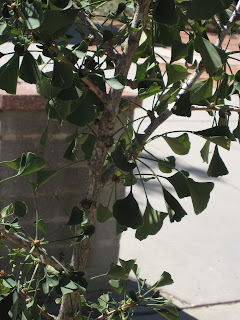
... well, sit down on a rock and have a couple of pictures taken!
This day and place exemplify my penchant for taking "wrong turns" or going the "wrong direction", and finding something even better. In January, my sister, Faith, and I went on a lovely hike at a place different than where we originally headed, and the exact opposite direction from where we were "supposed to be." (Hmm... says who?)
By chance, last month we ended up at Rancho Sierra Vista/Satwiwa, a National Park Service property located in Newbury Park, California. During a brief hike in which we got just a little "lost", magically, a Park Ranger appeared to give us guidance at just the right moment. Later, we spent some time at the Visitor's Center. While I spent quite a bit of time looking around the small but diverse native plant garden outside, Faith, a teacher, was keen to go inside and browse the children's literature. Her third grade class was to begin a section studying local Native American people the very next school day! We both were satisfied with a productive time of study, following exhilarating exercise in the fresh air. Below are a few photos of plants in the garden, with signs giving their common and botanical names as well as descriptions of their uses by Chumash people:





The interpretive area at Satwiwa ("the bluffs") includes this replica of a traditional Chumash tribal or communal home, called an 'ap, with the top portion of the layered tule mat siding omitted to expose the support structure:

This type of siding (when complete, of course) provides natural water repellency during rain. Tule made of rush or wiregrass, such as Juncus effusus (Soft Rush), expands when wet. When dry it contracts, allowing ventilation.
After enjoying our January visit to Satwiwa, and having learned of a short hike to a waterfall, we decided to return soon, figuring we'd get the best view of the falls during the wet season. Were we wrong, or what?!
This morning, we initially followed my hunch and headed down a very narrow, slippery, muddy trail... obviously not the right path to the waterfall. We turned back and made our way to the Visitor Center to ask directions. The Ranger set us on the right path, and agreed that we should have a good time to see the falls.
Well, this is as far as I got...
The trail appearing behind me over my right shoulder in the above photo, fairly disappeared into the rushing stream. The crossing would have been too wet and cold for this slightly timid soul!
Faith made it about thirty feet further along, and snapped the pictures of me sitting down. I told her I would not come to her rescue, so she decided not to attempt the crossing either.
On this perfect day, we saw many lovely views...
And, we witnessed the courtship and mating of a pair of White-tailed Kites (Elanus leucurus.) Privacy puh-lease, sorry, no photos!
Stay tuned for our continuing adventures at Rancho Sierra Vista/Satwiwa... We have an excuse, now, to try another visit next month, hoping finally to see the alleged waterfall!




































